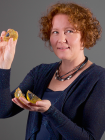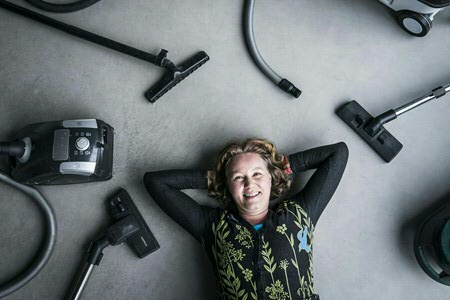Microplastics? Ventilate, ventilate and vacuum

It is becoming increasingly clear that our world is full of microplastics, and that this does not bode well. Prof. dr Barbro Melgert aims to find out what this does to our lungs, and hopes to receive a second ZonMW grant next year to continue her research at the UMCG.
When Barbro Melgert built a new house recently in the city of Groningen, she decided to include an expensive ventilation system that monitors CO2 levels in each room and automatically filters the air when the sensors detect abnormally high levels. ‘Yes, I know,’ she says, ‘lung research’, and laughs. ‘I can’t do anything about it, but it is very important to me.’
Plastic fibres
Melgert is Associate Professor of Immunology at the UMCG, specialized in lung diseases. She knows all about the research that shows that the indoor environment in well-insulated Dutch houses is, as she says, ‘terrible’. The reason is gases that are released during cooking or heating our homes that have not fully combusted. Mould that grows in air vents or on walls is also extremely bad for us. Even so, her latest worry is the presence of minuscule plastic fibres that float around our homes and that come from synthetic clothes and carpets. American research shows that 20 kilograms of dust accumulate each year American homes, of which 6 kilograms is made up of microplastics (smaller than 1 millimetre).
Mini lungs
As yet, little international research has been carried out into the impact of microplastics on our health. The Dutch health care research funding organization ZonMW therefore decided to award grants totalling €1.6 million to 15 small research projects this year. The projects were reviewed in October, and the results of Melgert’s research group were found to be one of the most remarkable. Melgert’s group grew mini lungs in petri dishes, to which they added nylon and polyester fibres. The nylon fibres had ‘a dramatic effect’ on the growth of the lung cells. Melgert does however suspect that much more nylon was added than people usually inhale. However, she cannot be sure, because no research has yet been done into the amount of microplastics in our lungs.

Close to home
‘I had a lot of fun writing the grant application for this research project’, says Melgert. ‘It is a socially relevant issue, and incredibly close to home. Although I study lung disease, I don’t suffer from it myself so it has less of an immediate effect on me. However, there are microplastics in my own home. We know so little about microplastics, while we know that there is a lot of it in the environment, and microplastics are found even in the deepest crevices in the Himalayas. The problem is getting worse and worse.’
Accumulating
A problem? Is it not a little early to talk of a problem? Strictly speaking, we don’t yet know whether microplastics are bad for our health. However, Melgert, who drinks her tea from a metal cup for this very reason, thinks otherwise. ‘Anything is a potential problem if it accumulates, and whether something is toxic or not doesn’t depend on the dosage. After all, water is also poisonous if you drink enough of it. If we continue to use and dispose of plastics as we do, we will automatically reach a point at which it becomes toxic, because plastic does not decay. It is a similar problem to the heavy metals that accumulate in the food chain, from microorganisms to vertebrates. We then eat a fish and ingest a huge amount ourselves. It is the same with microplastics.’
What is the cause?
Melgert has up to May 2020 to continue her research. After that, her hopes are set on a new funding round as ZonMW has announced that it will put aside an extra million euros for follow-up research. But first of all, she is working with the research institute TNO to find out exactly what is leaking from the plastic fibres. It is clear that something out of the used nylon strongly affects the lung cells in her petri dishes. The manufacturer of the nylon and polyester assert that nothing has been added to the plastics, so no softeners, which are additives that make plastic more flexible, and some of which have been known to harm our health for some time.
Smoke machine
Plastics have the unusual characteristic of being lipophilic, or fat-loving. That means that everything sticks to them, including diesel particles and cigarette smoke, but also microorganisms such as viruses, bacteria and mould. ‘It is possible that the manufacturer is right and that other particles in the environment have stuck to the microplastics’, says Melgert. ‘For example, if you visit a bar where people are smoking, you can still smell the smoke later because your clothes attract the smoke particles in the air. So, depending on where your clothes have been – such as China, where air pollution can be high – all kinds of things could be stuck to them. This is also part of our research: what happens when particles in the air stick to the microplastics?’ Melgert uses a smoke machine and a diesel motor in her laboratory. She also has a washing machine and dryer that her team uses to obtain fibres from the synthetic clothes, which therefore contain microplastics, for further study.
Sophisticated machine
Research into the health impacts of microplastics is still riddled with questions. Leaving aside the fact that all plastics are different and therefore have different effects on our health, the human immune system is a highly sophisticated machine. This makes it a painstaking search to work out exactly which cells in the cultivated mini lungs are affected by the microplastics, which proteins are ‘expressed’, how their DNA can be ‘read’, and which receptor on the outside of the cell is ‘down regulated’, as Melgert puts it.
Ventilate
Whatever the result of the research, it doesn’t change the message that the immunologist wants to get across: ‘Ventilate, ventilate, ventilate and vacuum. There is so much attention paid to the energy transition, to insulating our homes and minimizing energy use’, says Melgert. ‘But the cost of this is poor ventilation. What gets me is that people think only of their wallets when it comes to the climate inside their homes. “If I open a window all the warm air will escape and I’ll need to use more gas.” That’s true, but you’ll be stuck at home with COPD and will have saved ten euros. That’s taking things to extremes, sure, but we’re talking about our lungs. You have only got one pair, and you can’t get them fixed, so think of your health too, not just your wallet.’
Barbro Melgert is Associate Professor in Immunology at the UMCG/UG. She graduated with a degree in pharmacy in 1994 and received her PhD for research into the treatment of liver fibrosis in 2000. Her postdoctoral research involved studying the effects of smoking and the role of gender on the development of asthma. She had a particular interest in macrophages, an important cell in the immune system that digests viruses, bacteria and other foreign substances. Since May 2019, she has been carrying out research into the effect of microplastic fibres on our lungs. She hopes that ZonMW will extend its grant to allow her to expand her research.
Text: Jurgen Tiekstra. This article has been taken from our alumni magazine Broerstraat 5.
More news
-
17 November 2025
Artificial intelligence in healthcare
-
04 November 2025
AI Factory in Groningen advances digital sovereignty
-
03 November 2025
Menopause in perspective: How the media influences our perception
